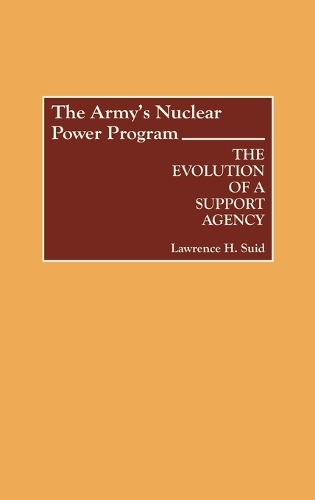
The Army's Nuclear Power Program: The Evolution of a Support Agency
(Hardback)
Publishing Details
The Army's Nuclear Power Program: The Evolution of a Support Agency
By (Author) Lawrence H. Suid
Bloomsbury Publishing PLC
Praeger Publishers Inc
21st August 1990
United States
Classifications
Tertiary Education
Non Fiction
History of engineering and technology
History: specific events and topics
Nuclear weapons
Military and defence strategy
623.451190973
Physical Properties
Hardback
160
Width 156mm, Height 235mm
425g
Description
On August 6 and August 9, 1945, the world became aware of the destructiveness of nuclear energy when the US Army Air Corps dropped atomic bombs on Hiroshima and Nagasaki. Even before the bombs were detonated, though, President Harry Truman had directed his thoughts toward non-military uses of the atom, recognising that the atomic bomb had given man a new understanding of the forces of nature. This book examines the history and development of nuclear power from the perspective of the US Army's nuclear power programme, telling its story from the creation of the Office of Research and Development through the programme's days of growth, and on to its eventual decline. This history examines the development of the United States Army's nuclear power programme from its inception, through the development and operation of six small nuclear power plants throughout the Western Hemisphere, to its evolution into a military support agency. The Manhattan Project District Engineer, General Kenneth Nicols, who generated the idea for the programme, worked for the development of atomic energy for peaceful purposes. From the initial plans to develop nuclear power plants at remote bases, the book traces the path the Army took in getting its proposals approved by the Atomic Energy Commission, formally organizing the nuclear programme, and building a prototype of a nuclear power plant. Seperate chapters are devoted to Fort Greely, the nuclear programme at the height of its success and accomplishment, and its subsequent decline and transitional period.
Reviews
. . . Suid provides a step-by-step analysis of the feasibility of developing nuclear power and the acquisition of technology needed to generate electricity from the atom, explaining that President Harry S. Truman envisioned atomic energy as a supplement to power derived from coal, oil, and falling water. It was Truman's desire to control the production and use of atomic energy within the United States. He also asked Congress to establish a commission to determine how atomic power could be used to influence world peace. Suid then examines the history and development of nuclear power from the perspective of the Army's Nuclear Power Program. He takes the reader from the inception of the program through its growth to its eventual decline. . . .-The Friday Review of Defense Literature
." . . Suid provides a step-by-step analysis of the feasibility of developing nuclear power and the acquisition of technology needed to generate electricity from the atom, explaining that President Harry S. Truman envisioned atomic energy as a supplement to power derived from coal, oil, and falling water. It was Truman's desire to control the production and use of atomic energy within the United States. He also asked Congress to establish a commission to determine how atomic power could be used to influence world peace. Suid then examines the history and development of nuclear power from the perspective of the Army's Nuclear Power Program. He takes the reader from the inception of the program through its growth to its eventual decline. . . ."-The Friday Review of Defense Literature
Author Bio
LAWRENCE H. SUID is a Washington-based military historian and independent writer. He is the author of Guts & Glory, Scenes of Conflict, and The History of Armed Forces Radio and Television Service.
